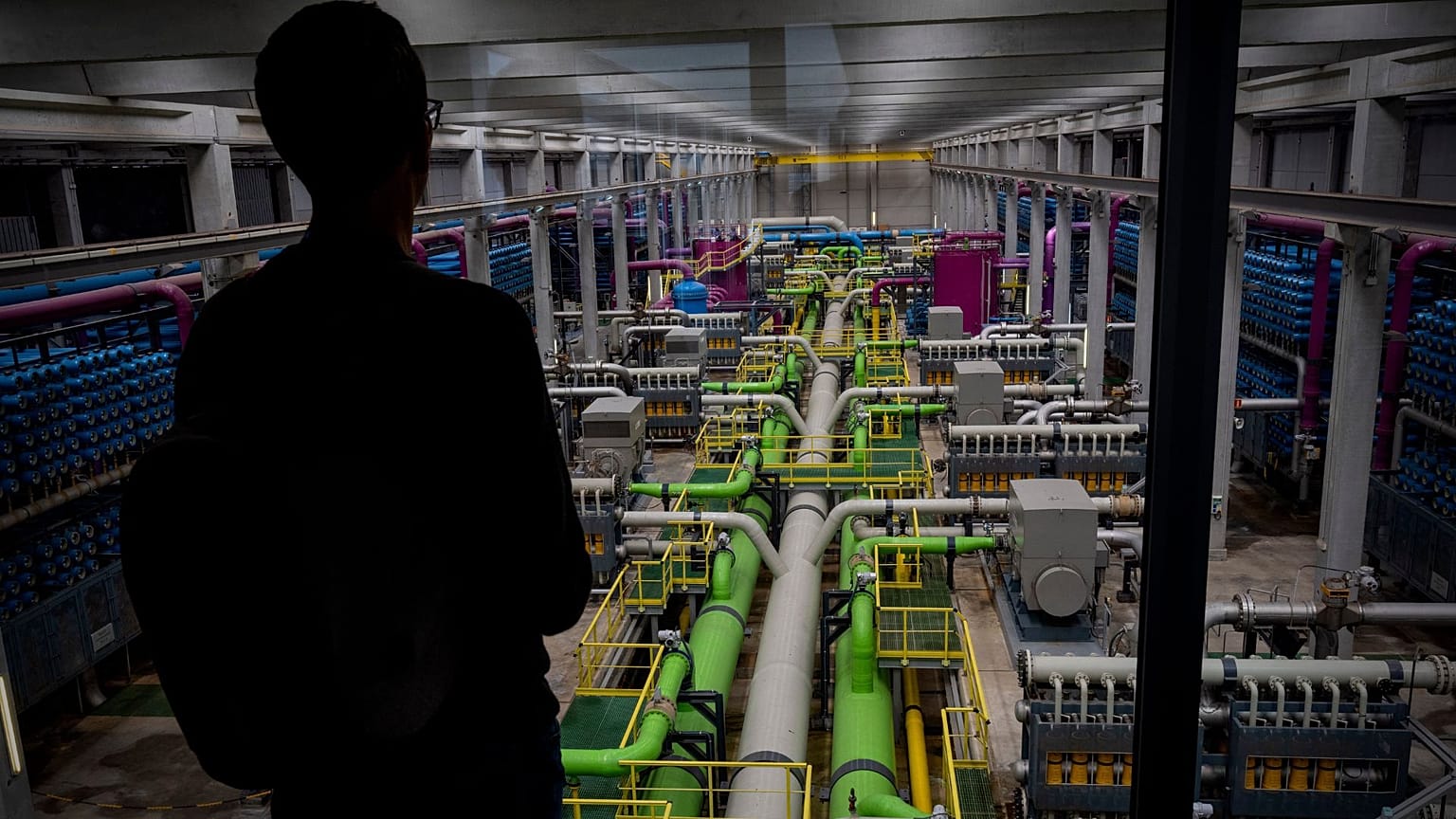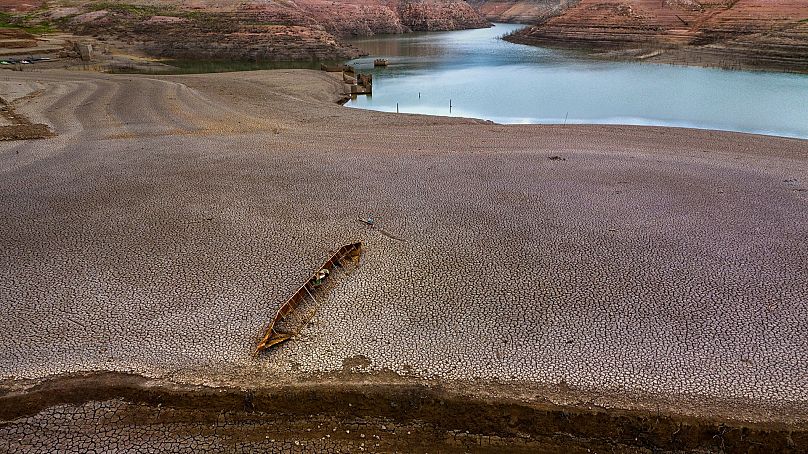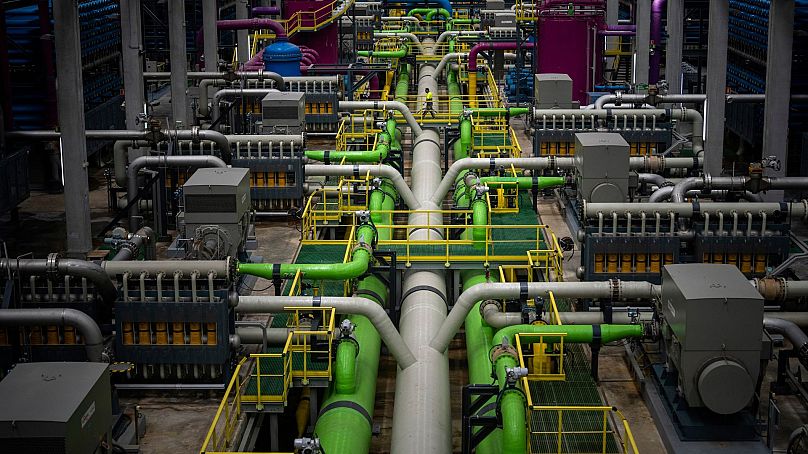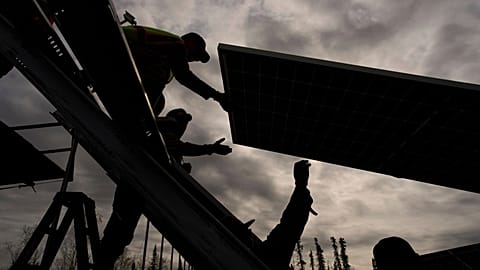Barcelona is leaning on Europe’s largest desalination plant as drought squeezes water supplies.
When we think about the circular economy, repairing and recycling products usually springs to mind. But there’s a major element that often gets overlooked: water.
As a finite resource that sustains all life on Earth, water is integral for our survival.
With parts of Europe facing severe drought, the water crisis has never felt closer to home.
Responsible management of this precious resource is essential as supplies are threatened by unpredictable weather and growing populations.
With fresh water reserves dwindling due to heatwaves and drought, Barcelona is turning to Europe’s largest water desalination plant as a lifeline for parched residents.
Where once Spain’s second city drank mostly from its rivers and wells, it now relies on a labyrinth-like mesh of green, blue and purple pipes inside an industrial plant to keep it from going thirsty.
Barely used after being built in 2009, the desalination plant is running at full throttle to help the greater Barcelona area and some five million people adapt to the impact of climate change.
How does Barcelona’s desalination plant work?
The Llobregat desalination plant pumps water from two kilometres into the Mediterranean Sea to where it sits on an isolated stretch of beach.
After journeying through several cleaning and filtering systems it reaches its final stop: the twisting and turning multi-colored channels that squeeze every drop of water free of its salt.
In April 2021, before the drought, rivers provided 63 per cent of Barcelona’s drinking water, wells provided 34 per cent and desalination just 3 per cent.
Two years later desalination makes up 33 per cent of the city’s drinking water, while wells provide 23 per cent and its shrinking rivers just 19 per cent, according to Barcelona’s municipal water company.
Why does Barcelona need a desalination plant?
The Mediterranean region is heating up at a faster rate than many other areas of the globe. This led to a record-hot 2022 in Spain and a widespread drought that is hurting agriculture.
The lack of water is particularly acute in northeast Catalonia, whose water agency forecasts that its water resources will shrink by 18 per cent before 2050.
The reservoirs fed by Catalonia’s northern river basins are currently at just 25 per cent capacity. Limits have been placed on the amount of water available for agriculture, industry and some municipal uses.
But authorities have not yet had to take drastic action like during the 2006-2008 drought when tanker vessels shipped in drinking water.
“We knew that sooner or later a drought would come,” says Carlos Miguel, manager of the Llobregat plant.
“As long as the drought continues the plant will keep running. That is clear.”
Water authorities predict that the Barcelona area is heading for an official ‘drought emergency’, which will imply tighter restrictions, by September.
“We forecast that for the rest of May rainfall will be above average, but that does not make up for 32 months of drought,” says Samuel Reyes, head of the Catalan Water Agency.
Is the desalination plant sustainable?
While the building of the Llobregat plant is the result of authorities heeding warnings from climate experts and planning ahead, it comes at high economic and environmental costs.
In the desalination process at the Llobregat plant, for every 0.45 litres of fresh water, around 0.55 litres of extremely salty brine is produced as waste. This is dumped into the sea, where its super salty load can hurt the ecosystem.
Another pressing problem for the planet is the energy-intensive processes involved in desalination.
The reverse osmosis process, where high pressure forces seawater through membranes which separates the salt, requires a lot of energy that doesn't yet come entirely from renewable energy sources.
Spain generated 42 per cent of its electricity from renewable energy sources in 2022 and it hopes to reach 50 per cent this year, but it still uses large amounts of planet-warming natural gas. The electricity generated by the solar panels on the Llobregat plant goes into the electrical grid, not directly to the site's operations.
Tourism and agriculture strain water resources in Spain
Julio Barea, water expert for Greenpeace in Spain, emphasises that desalination is not a cure-all.
Barea cites the steady increase of water use in Spain over past decades to support two of the country’s economic pillars: agriculture and tourism.
Some 80 per cent of Spain’s water goes to agriculture, Greenpeace calculates, while coastal areas including Barcelona are huge tourist magnets, many offering hotels with swimming pools that need filling. Soon-to-be implemented water restrictions in Catalonia will prohibit the filling of private pools, while hotels will still be able to fill theirs.
“[Authorities] have to provide drinking water for people, but desalination plants have an impact because they are essentially water factories that need a lot of energy,” says Barea. “It should be a last resource, and we should ask ourselves how we have gotten into this situation.”
Where else relies on desalination?
Desalination has formed a key part of Spain’s water policy for over half a century.
The island of Lanzarote in Spain’s Canary Islands archipelago installed Europe’s first desalination plant back in 1964. The industry has kept growing in the southern European country prone to long, dry summers.
The development and spread of the reverse osmosis technique in the 1980s and 90s, along with reduced costs, led to its buildout across many areas of mainland Spain.
Spain is now fourth in the world for its desalination capacity, about 5 per cent of the global total, behind Saudi Arabia, the United States and the United Arab Emirates, according to the Spanish Association of Desalination and Water Re-utilization.
Desalination capacity has steadily gone up worldwide in the past decade, with the technology seeing a bigger uptick in Europe and Africa.
Spain has some 800 desalination plants that can produce 5 million cubic litres a day of water for drinking, agriculture and industry. If that were dedicated solely for human consumption, it would quench the thirst of 34 million people - over 70 per cent of Spain's population.
As part of a €2.2-billion drought response package, Spain's national government said this week that it was setting aside €220 million to expand another desalination plant north of Barcelona, plus another €200 million for a plant on Spain's southern coast. It also pledged to spend €224 million on improving water purification systems in southern Spain.
This small miracle of scientific innovation, however, includes even more costs.
How much does desalination cost?
According to the public company that runs the Llobregat plant, a thousand litres of desalinated water costs €0.70 to produce, compared to €0.20 euros for the same quantity of water pulled from the Llobregat river and purified for drinking. That means a heavier tax burden and, possibly, higher water bills.
Xavier Sánchez-Vila, professor of civil engineering and groundwater expert for the Universitat Politècnica de Catalunya, said that while desalination plants like the one in Barcelona have provided a lifeline in a time of crisis, authorities should continue to diversify their strategies and focus on improving water purification and reuse.
“Of course, with climate change we know that droughts are going to be more frequent and therefore there is this need [for desalination]," he says. “But in economic terms, I am not completely sure whether it makes sense to keep building them. A few more maybe, but knowing that these are a really expensive solution.”
What are the alternatives to desalination?
As urban populations continue to grow, cities across the world will require more water, and produce more wastewater and water pollution. Meanwhile, droughts are set to become more frequent and severe, according to the UN.
Relying on a linear model of use and disposal is therefore no longer viable.
So how else can we leverage the circular economy for water reuse and recycling?
As an alternative to desalination, Sánchez-Vila applauds the boost in Barcelona's use of treated sewage water in a separate treatment plant sitting next to the Llobregat facility. This treated water that is reintroduced upstream and then available to be pulled back into the city’s supply now accounts for 25 per cent of Barcelona’s water.
This can be applied on a smaller scale in the home, with buildings designed to make use of water more than once in a ‘cascading’ format - for example, water from showers being reused to flush toilets.
Agricultural wastewater could be purified naturally using constructed wetlands, which feature plants that take up nitrogen and phosphate.
Tackling one of the key underlying causes of water scarcity - climate change - by curbing greenhouse gas emissions remains essential.




















